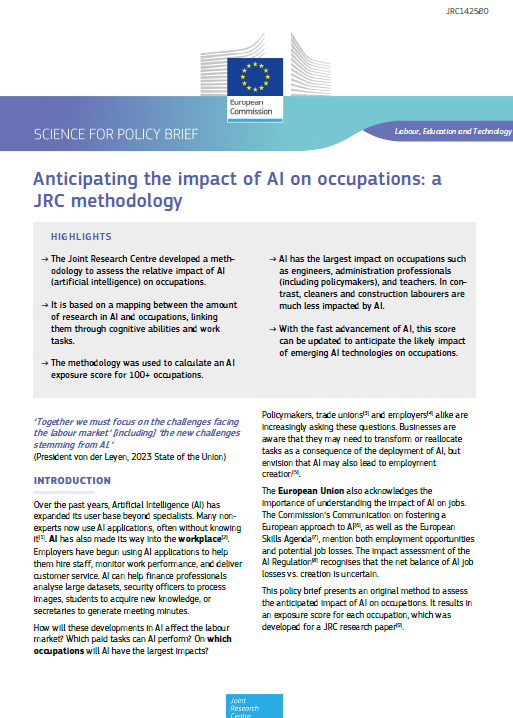
A methodology developed by the European Commission’s Joint Research Centre (JRC) allows to assess which occupations are most likely to be affected by artificial intelligence (AI). By linking AI research benchmarks to cognitive abilities and real-world job tasks, the JRC has created an “AI exposure score” that identifies which jobs are more susceptible to disruption or transformation as AI systems evolve.
The analysis reveals a clear divide: professions built on comprehension, finding relevant information and abstract reasoning, such as engineers, teachers, and policymakers, are far more exposed to AI than those involving manual and physicalwork, such as cleaners or construction workers.
A cognitive bridge between AI and labour
At the heart of the methodology is an innovative mapping system. AI research benchmarks, like the Stanford Question Answering Dataset or CIFAR-10 image recognition, are associated with the cognitive abilities they require, such as comprehension, visual processing, or abstraction. These abilities are then connected to work tasks and, successively, to over 100 occupations listed in the International Standard Classification of Occupations (ISCO).
High exposure for high-income, cognitive-heavy jobs
The findings reveal a counterintuitive trend compared to previous waves of automation. Unlike past technologies, such as robotisation, which primarily affected low-skilled, manual jobs, AI appears to target professions demanding complex cognitive skills.
Electrotechnology engineers, software developers, office clerks, and secondary school teachers are among those with the highest AI exposure scores. Teachers, for instance, ranked as more exposed than 90% of other occupations.
One illustrative case is policymakers. Categorised under “administration professionals,” their tasks, negotiation, information synthesis, deduction and induction tasks., depend on high-level cognitive abilities like expression, conceptualisation, and abstraction. These are precisely the domains in which AI research has advanced most rapidly.
Conversely, jobs that hinge on sensorimotor skills or navigation, areas where AI research remains limited, such as waiters, cashiers, and agricultural workers, show significantly lower exposure.
Research trends reinforce the divide
Data collected from 2020 to 2024 suggests that AI research continues to deepen its focus on text, image, and video processing, further enhancing AI’s capabilities in abstract cognitive functions. Benchmarks like GLUE for sentiment analysis and ImageNet for object recognition indicate an expanding AI frontier in areas most aligned with analytical or academic professions.
This progression implies that the pattern observed before 2020 is likely to intensify. As AI becomes more proficient in generating and processing information, the jobs relying on those skills will face growing pressure to adapt.
Policy implications: Preparing for transformation
While high exposure to AI does not necessarily mean that jobs will disappear, it signals that their content may change significantly. AI may take over specific tasks, such as drafting documents or processing information, rather than replacing entire professions.
The JRC underlines that this transformation requires a dual policy response. Education systems must equip workers not only to use AI tools but also to complement them by reinforcing uniquely human strengths, such as emotional intelligence, communication, and complex judgment. Employment strategies, meanwhile, must address the risks of occupational polarisation, potential wage shifts, and the need for workforce adaptability.
Importantly, the methodology allows for continuous monitoring. As new AI research areas emerge, the AI exposure score can be recalibrated to anticipate shifts in the labour market. This dynamic tool equips policymakers and scientists alike with foresight into how emerging technologies may reshape professional landscapes.
As Commission President Ursula von der Leyen noted in her 2023 State of the Union address, Europe must “focus on the new challenges stemming from AI.” The JRC’s contribution offers a critical evidence base for doing just that.
Details
- Publication date
- 30 June 2025
- Author
- Joint Research Centre
